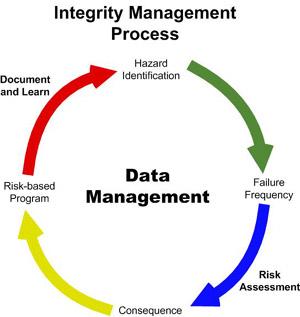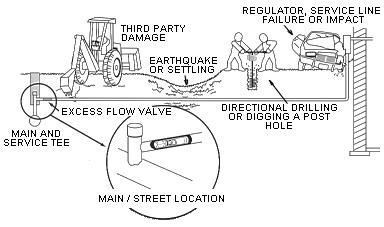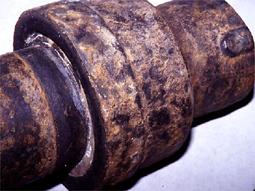GPSU Inspection Program
What is the Gas Pipeline Safety Unit Inspection Program?Intrastate Facilities
The Gas Pipeline Safety Unit uses a combination of field inspections of new construction, and operation and maintenance of pipeline facilities and plants, as well as reviews of company plans, procedures and records, to ensure compliance with applicable safety requirements. Statistical information and risk assessments are used to focus the program. Inspections are performed by qualified engineers with specific training in the field of pipeline safety. The Gas Pipeline Safety Unit performs approximately 500 field inspections per year. View a list of inspections performed by the Gas Pipeline Safety Unit.


The Gas Pipeline Safety Unit selects certain new construction activities to be inspected to ensure that the facilities are installed properly, in accordance with applicable State and federal requirements and the company procedures. If the facilities are installed properly, they should provide safe service for a long, long time. The inspection includes ensuring that persons performing safety sensitive tasks are properly qualified in accordance with the Operator Qualification requirements and are aware of the abnormal operating conditions associated with those functions. New construction inspections are performed throughout the year and comprise approximately 30 to 40 percent of our annual inspections.
Gas companies are required to develop and follow detailed written plans, and to review their plans and procedures periodically to ensure completeness, clarity and compliance with applicable State and federal safety requirements. The Gas Pipeline Safety Unit reviews the plans and programs, including records of the facilities, to ensure compliance with the plans and procedures. These audits are performed every other year on natural gas companies and at least every fifth year on propane companies. These cover:
- the design and construction of pipeline facilities;
- routine operation and maintenance of facilities;
- emergency plans to respond to problems with the system, including coordinating response with local emergency response personnel;
- operator qualification programs to ensure that gas company personnel have the necessary knowledge, skills and ability to safely and properly perform safety sensitive tasks, including recognizing potential problems;
- procedures for investigating accidents and failures
- procedures for evaluating the integrity of the existing pipeline system and developing criteria and plans for pipeline replacement to ensure the safety of the gas facilities.
4. Operation and Maintenance Inspections
The Gas Pipeline Safety Unit reviews actual operation and maintenance activities of the gas operators to ensure compliance with applicable requirements and record keeping associated with those activities. The inspection includes ensuring that persons performing safety sensitive tasks are properly qualified in accordance with the Operator Qualification requirements and are aware of the abnormal operating conditions associated with those functions. These types of inspections are performed throughout the year.
Gas companies have mandatory risk-based pipe replacement programs. Using the best available technical and engineering data, facilities are evaluated based on particular factors to identify those facilities that seem to represent the greatest danger to public safety. These facilities are targeted for attention. In addition, pending replacement of facilities, additional leakage surveys may be performed to provide increased levels of attention where safety concerns are the greatest. Distribution Integrity Management Programs (DIMP) include additional leakage survey and other requirements to risk-manage the distribution system.
Since damage by excavation activity is one of the primary causes of serious natural gas incidents, each gas operator has a program designed to minimize damage from excavation activity. The center point of this is the State excavation damage prevention program and one-call system. Hundreds of damage prevention inspections are performed each year.
When a significant incident occurs, the Gas Pipeline Safety Unit performs an investigation as to the cause of the incident. Under State and federal law, the PURA has the statutory authority and obligation to investigate pipeline failures and incidents. The Gas Pipeline Safety Unit has authority to ensure necessary safety activities of the gas operators to protect the public and emergency responders, as well as overseeing the safe restoration of any facilities that are shutoff. The Gas Pipeline Safety Unit works cooperatively with other governmental agencies at incidents to determine hazards, safely deal with the hazards, resolve any safety issues, and investigate the causes of the incident. Cooperative efforts, using the expertise and professional competence of all parties, ensures public safety. The objective of the investigation is to determine the cause of the incident in order to minimize a recurrence of that type of failure. View a list of incidents.
The Gas Pipeline Safety routinely receives reports of various kinds about the pipeline systems, including leak reports, employee accident reports and excavator damage reports. We routinely receive inquiries from excavators, customers and the general public related to issues of pipeline safety.
In cooperation with the gas operators, the Gas Pipeline Safety Unit is active in providing training for local fire departments and other emergency responders regarding gas incident. It is the obligation of all interstate and intrastate pipelines to coordinate with local officials in planning for potential emergencies. Emergency responders are encouraged to attend such training sessions. If they feel a need for additional training or information, they should contact the gas operator or the Gas Pipeline Safety Unit.
Liquefied Natural Gas (LNG) plants are facilities for making LNG (or receiving LNG by truck), storing the cryogenic liquid (-260°F) until times of peak demand, and vaporizing the LNG for use by customers throughout the distribution system.
These facilities are inspected annually by the Gas Pipeline Safety Unit to ensure compliance with applicable safety requirements and to ensure they are ready to provide the necessary service to gas customers.
Work has been underway for several years at the federal level to develop new regulations to require each distribution operator to develop a Distribution Integrity Management Plan (DIMP). Connecticut has actively worked with OPS in the Distribution IMP process. The Distribution IMP regulations became effective August 2, 2011. The distribution IMP program requires a written plan to address seven elements:
|
 |
 In addition, there are requirements for the use
of an Excess Flow Valve (a device installed in a gas pipeline to
automatically restrict or shut off the gas flow
through the line when the flow exceeds a predetermined limit) (EFV) on certain
service lines.
In addition, there are requirements for the use
of an Excess Flow Valve (a device installed in a gas pipeline to
automatically restrict or shut off the gas flow
through the line when the flow exceeds a predetermined limit) (EFV) on certain
service lines.
In Connecticut, we have been active historically in integrity programs to improve the safety of Connecticut citizens. We have developed risk management programs to identify and implement additional and accelerated operation and maintenance activities, such as more frequent leakage detection surveys, as well as risk-based pipeline replacement programs. Also, it has been standard practice to install EFVs where their use is practicable.
Interstate Facilities
1. General
The Gas Pipeline Safety Unit coordinates with the Pipeline and Hazardous
Materials Administration (PHMSA) Office of Pipeline Safety (OPS) Eastern
Region in developing an annual inspection plan for the interstate operators in
Interstate transmission lines are subject to extensive regulations related to IMP. This requires detailed analysis of the current state of the pipeline system and remedial actions where necessary to ensure the integrity of the pipeline.
9. Integrity Management Program


